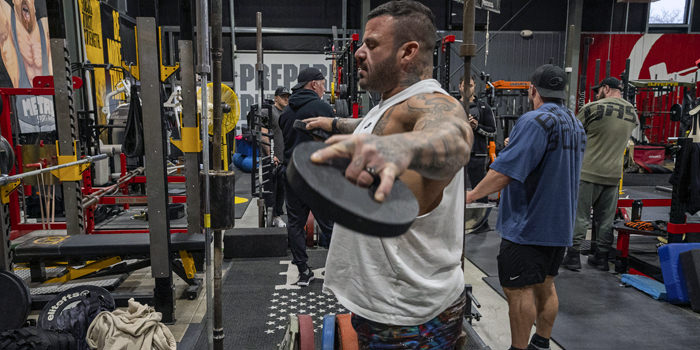
You’ve just competed, now what? To make the most of your powerlifting offseason, you'll need to focus on a few main areas of growth. Keep reading to hear advice decorated Powerlifter Trevor Jaffe has for you.
Powerlifting is a very specific strength sport that involves lifting as much weight as possible in three main lifts: squat, bench press, and deadlift. For powerlifters, building strength during the offseason is crucial. That being said, there rarely is a true powerlifting offseason when it comes to building and refining strength. The time in between meets allows for attention to be placed on improving areas of opportunity, or less kindly put weaknesses. Time can also be devoted to investing time in building up more muscle mass, better known as Hypertrophy.
The Three Main Lifts
The key to a successful powerlifting offseason building plan for a raw powerlifter is to focus on compound exercises that target the muscles used in the three main lifts. For the squat, exercises such as high bar squats, SSB Yoke squats, hack squats, and unilateral squat variations such as Bulgarian split squats all target the prime movers - the quadriceps. The area often neglected in the main lifts performed on a meet day is the torso. The powerlifting offseason is a great time to include torso-specific variations such as front and Zercher squats.
For the bench press, we keep them mechanically similar to the staple lifts, such as close-grip bench presses, incline bench presses, and dumbbell bench presses that help to target different areas of the chest and triceps. To improve overall pressing strength we can add in more over-head press variations as well as spending more time building up back thickness to create a wider base of support for the press. Now it is time to double up on our row variations. Seal rows can be seen as benching in reverse and really help condition the position we bench from. By adding in more volume from machine rows and shrugs (both done upright or in a prone incline) we thicken the back, which supports the press. Yes, we also include more curls because they contribute to the eccentric portion of the bench and the health of your shoulders and elbows.
For the deadlift, exercises such as deficit deadlifts, snatch grip deadlifts, and Romanian deadlifts can help to strengthen the primary muscles in the movement. Namely quads, hamstrings, adductors, glutes, and lower back.
These all take you through some form of extended range of motion making them more challenging than the actual competition deadlift. The offseason is a great time to work position builders in the deadlift. Paused or halted deadlifts help to build pattern awareness.
Accessory Work
In addition to our primary exercise selections, accessory work can also help to improve overall strength and muscle mass. Accessory exercises such as chin-ups, rows, dips, and pushups can help to add mass to the upper body, while exercises such as lunges, step-ups, and Glute Ham raises can help to improve lower body muscle mass. It is important to incorporate these accessory exercises strategically, targeting weaknesses and evening out muscular imbalances to ensure a well-functioning body.
Here is where post-competition gets fun! Meet prep can be very monotonous focusing primarily on the big three lifts. Part of a well-mapped out post-meet block includes work to increase work capacity or general physical preparation. See the strongman equipment on the other side of the gym? Good, let’s have some fun with it during your offseason. Yoke walks, farmer carries, and sled work will all challenge you in different ways than your normal barbell-based training. Strongman implements can improve grip strength, torso strength, and hip strength as well as challenge your dynamic stability in ways the barbell simply can’t. You might even make a new friend at the gym to teach you about strongman lifting.
Diet and Nutrition
Diet and nutrition are always crucial components when planning as a raw powerlifter. This doesn't stop during the powerlifting offseason. Eating a calculated and performance-based diet with sufficient protein, carbohydrates, and healthy fats can help to fuel workouts and support muscle growth. It is important to understand your macronutrient needs to facilitate your offseason goals. Whether that is to bulk up or cut down, macronutrient is an essential component to improve recovery and growth. Do not neglect your micronutrient needs as well. Small elements, such as sodium intake, serve a vital role in performance.
Here is an example week set-up structure to follow based on a four times a week training for your powerlifting offseason. This would be week one of however long you prefer your blocks to last.
Powerlifting Offseason Program
Day 1 - Squat
Main movement - pick primary weakness. Possibly torso builder or quad builder. 3-5 sets in a hypertrophy specific rep range 6-12 reps
Secondary movement - position builder, such as pauses, tempo, or selective range builder. For example, 1.5 rep Squats. 2-3 sets may be done in either a strength or hypertrophy-specific reps range of 3-12 reps.
Third or more movements - choose 1-3 accessory lifts that target the quads, hamstrings, and low back. 2-4 sets of each in a strength endurance and hypertrophy rep range 12-20 reps.
Last movement - core work such as Planks, Side Planks, Decline Sit-Ups, or Wheel Rollouts.
Day 2- Bench
Main movement - pick primary weakness. For example, a chest builder or compound tricep builder barbell based. 3-5 sets in a hypertrophy specific rep range 6-12 reps.
Secondary movement - position builder, such as pauses, tempo, or stability builders like Larsen Press or feet up Bench Press. Do these in 2-3 sets that may be done in either a strength or hypertrophy specific reps range 3-12 reps.
Third or more movements - choose 1-3 accessory lifts that target the pecs, delts, upper back, and triceps. 2-4 sets of each in a strength endurance and hypertrophy rep range 12-20 reps.
Last movement - Shoulder health targeting the rotator cuff muscles - Face Pulls, Prone Scarecrows, Band External and Internal rotations at endurance reps ranges 20-30 reps.
Day 3 - Deadlift
Main movement - pick a primary weakness, like extending range of motion work or position builder. 3-5 sets in a hypertrophy specific rep range 6-10 reps, but we may be better served with 8 reps as a maximum to avoid too much back fatigue.
Secondary movement - Loaded hinge pattern work. Such as Stiff Leg Deadlifts, RDL, or Good Mornings. Or partial range work such as Block Pulls or Rack Pulls. 2-3 sets that may be done in either a strength or hypertrophy specific reps range 3-12 reps.
Third or more movements - choose 1-3 accessory lifts that target the quads, hamstrings, and low back. 2-4 sets of each in a strength endurance and hypertrophy rep range 12-20 reps.
Last movement - core work such as Planks, Side Planks, Decline Sit-Ups, or Wheel Rollouts.
Day 4- Upper Accessory
Main movement - Press accessory done for volume. Such as Overhead Press, Incline Presses, or any Dumbbell Press variation targeting the pecs delts, and triceps. 4-6 sets in a hypertrophy specific rep range 6-12 reps.
Secondary and accessory movements - choose 3-5 accessory lifts that target the pecs, delts, upper back, biceps, and triceps. If possible try to include both a vertical pulling movement and a horizontal pulling movement. 2-4 sets of each in a strength endurance and hypertrophy rep range 12-20 reps.
Last movement - Shoulder health targeting the rotator cuff muscles - Face Pulls, Prone Scarecrows, Band External and Internal Rotations at endurance reps range 20-30 reps.
An effective powerlifting offseason building plan for a raw powerlifter should include compound exercises that target the muscles used in the three main lifts, accessory work to improve overall strength and muscle mass, a balanced diet with sufficient protein, carbohydrates, and healthy fats, and an emphasis on rest and recovery. This helps to prevent burnout and maximize the benefits of training. With dedicated programming and discipline with your nutrition during the offseason, you will set yourself up for success in competition.

Trevor Jaffe has been a competitive strength athlete for over 18 years. He has received first place finishes in strongman, weightlifting, and places his primary focus on powerlifting. With top lifts of a 683-pound squat and an 810-pound deadlift, he has totaled International Elite in three weight classes (181, 198, and 220).
He has coached over 25 all-time world records with eight separate athletes: Dallas Norris, Jenn Rotsinger, Ashley Garcia, Phil Herndon, Jordan Wong, Stacy "Bama" Burr, and Danny Misencik.
Trevor currently holds the masters ATWR total for 181 and deadlift, along with the 198 and 220 class ATWR deadlift. Affectionately known as "the deadlift whisperer" for his ability to improve the deadlift, Trevor is also known for improving a lifter's mechanics and technique in a short time frame and significantly prolonging an athlete's competitive career.
Trevor is also the co-host of The Strength and Success Show and co-owner of Cultra Nutra Supplements.
Trevor Jaffe trevorjaffe@gmail.com









